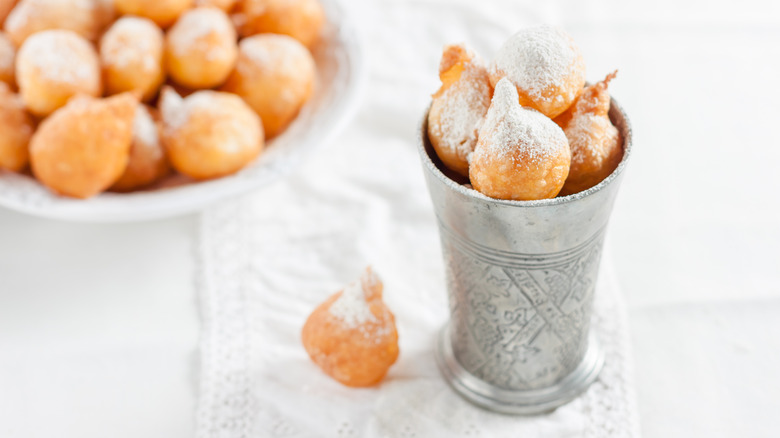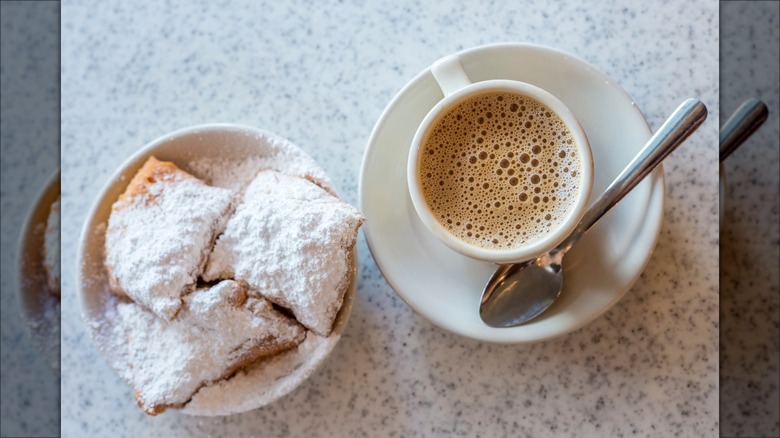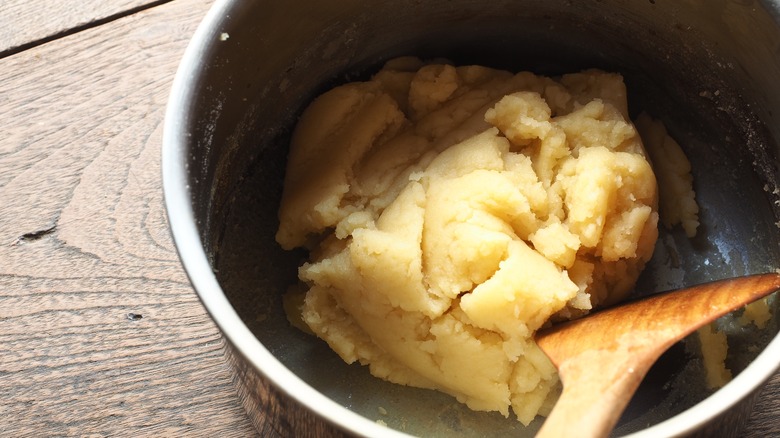The Difference Between French And New Orleans-Style Beignets
Depending on your associations, the word beignet might conjure images of small, round pastries found in Parisian bakeries, or powdered sugar-doused squares served in bustling New Orleans cafés. Maybe, you're not familiar with the word at all — if so, it's high time for an introduction.
Beignet can have different meanings in different contexts. In French, it's roughly equivalent to the English word fritter. Both words are used to describe a wide category of fried foods: small pieces of dough, sometimes wrapped around a sweet or savory filling. In France, the pastry that English speakers think of as French beignets go by many names: beignet souffle, boules de Berlin, and the mischievous term, pets de nonne — we'll come back to that. In some culinary contexts, the word specifically refers to fried choux pastry — a definition that New Orleanians would object to since New Orleans-style beignets are made from yeasted dough, not choux pastry. Despite their differences, New Orleans-style beignets are closely associated with French cuisine. The region has close ties to French culture, and French settlers are credited with bringing beignets to America — where they've taken on a life of their own.
What are French beignets?
French beignets are generally round, with a lighter, airier texture thanks to the puffy nature of choux pastry. They've been a part of French cuisine since the Middle Ages and come in many varieties. 15th-century French cookbooks describe both sweet and savory beignets; a 1605 cookbook author recommended eating them with apples. But today, they're typically served filled with jam or dusted with sugar.
By the 16th century, the French were eating beignets as part of Mardi Gras celebrations — a tradition that lives on in New Orleans. However, food historians have suggested that neither the fried pastries nor the cultural practices surrounding them originated in France. The French certainly didn't invent the concept of fried dough; ancient Romans had their own version, and variations can be found throughout Spain and Italy. In fact, the French called beignets made from choux pastry — what we now think of as French beignets — Spanish beignets throughout the Middle Ages.
Some historians believe that beignets, and the tradition of eating them on Mardi Gras, actually stem from Islamic influences. Early Islamic recipes describe a pastry known as lokma or luqam al qadi, a type of sweet fritter made with yeasted dough. Traditionally, Muslims eat luqam al qadi when they break the Ramadan fast. Christians may have adapted the tradition for their own holidays, eating the fritters on Mardi Gras in preparation for their own fast, Lent.
What are New Orleans-style beignets?
Made of yeasted dough and cut into squares, New Orleans-style beignets are deeply ingrained in the city's food culture. Throughout New Orleans, you can find creative variations on the beignet: stuffed, savory, and topped with fruit. True to the city's characteristic fusion cuisine, new iterations incorporate other local foods, like the crab-filled beignets found at Loretta's Authentic Pralines.
According to legend, a group of French nuns introduced beignets to the area when they arrived in the region in 1727. Other accounts suggest that Acadians, a group of French settlers from Canada, brought the recipe. By the mid-19th century, beignets were a mainstay of New Orleans coffee shops. The oldest surviving shop is Cafe du Monde, which opened its doors in 1862. Now, the original café, located in the French Market, operates 24 hours a day, seven days a week. Beignets are the only food item on the menu, typically served three to a plate with chicory coffee.
However, the pastries weren't called beignets when the café first opened. Until the 1950s, they were called doughnuts, and according to reporting done by NOLA.com, a 1958 headline in the Times-Picayune bemoaned that the "Good old doughnut has gone cultural on us" after French Market coffee stands started selling them as beignets. An enterprising manager remarked that the change was an effort to honor the pastry's heritage — and likely served as a marketing ploy, too.
French beignets are made from choux pastry
The shape and texture of French beignets come from a type of pastry dough called choux pastry, or pâte à choux to the French. Pastries made from choux are light, airy, and mostly hollow. In France, plain, round beignets made from choux pastry are called pets de nonne, which translates to nun's farts — and is likely a reference to the dessert's airy texture.
Choux is made from flour, water, eggs, and butter. That may seem like a pretty standard dough, but choux pastry has a few unique properties that set it apart. For one, it's cooked twice, once on the stovetop and once when it's baked or fried. The stovetop process gelatinizes starches in the flour, which keeps the dough moist. This moisture is key to the airy texture of beignets and other choux pastries: as the dough cooks, rising steam makes the pastry puff up. This puffy property is how cream puffs — another pastry made from choux dough — get their shape. Choux also provides the base for gougères, cream puffs, and eclairs, all set apart from beignets by the fact that they are typically baked, not fried. Choux pastry may be responsible for the round shape typically associated with French beignets. If you've ever worked with choux pastry, you'll know that it's not exactly easy: the dough can be sticky and difficult to shape.
New Orleans-style beignets are made with yeasted dough
In contrast to French beignets, New Orleans-style beignets have a denser texture. That's due to yeasted dough, which is standard in New Orleans recipes. Unlike choux pastry, it's easy to roll out yeasted dough and cut it into shapes, like the squares in New Orleans cafés or the popular Micky Mouse beignets served in Disney World's Port Orleans. Some New Orleans beignets, like those served at classic café Morning Call Coffee Stand, are made with sourdough batter. We'll likely never know the recipe for Cafe du Monde's world-famous beignets, though: it's a well-kept secret. According to NOLA.com, in 1928, a tourist asked to buy the recipe for $250, which is nearly 4,300 bucks today.
The key to why New Orleans-style beignets use yeasted dough rather than choux pastry may lie in local tradition. Oral histories recount that Cajun women would bake fresh loaves of bread each day, pulling off small chunks to turn into beignets. Rather than waiting for the dough to rise, they'd fry the chunks for a quick breakfast. These early iterations were served with cane syrup or fig preserves. Whatever the origin, they have an undeniable place in the city's rich culinary history.




